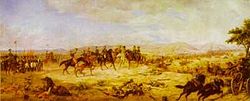Peruvian War of Independence
| This article may be expanded with text translated from thecorresponding article in Spanish Wikipedia. (July 2010) After translating, {{Translated|es|Peruvian War of Independence}} must be added to the talk page to ensure copyrightcompliance.Translation instructions · Translate via Google |
| Peruvian War of Independence | |||||||
|---|---|---|---|---|---|---|---|
| Part of Spanish American wars of independence | |||||||
 The Battle of Ayacucho | |||||||
| |||||||
| Belligerents | |||||||
| Army of the North United Liberating Army Pro-Independent Militias | |||||||
| Commanders and leaders | |||||||
| Francisco Antonio de Zela Victor Valdinario | José Fernando de Abascal | ||||||
| Strength | |||||||
| Pro-independence militias Army of the North United Liberating Army | Royalist Army | ||||||
The Peruvian War of Independence was a series of military conflicts beginning in 1809 that culminated in the proclamation of the independence of Peru by José de San Martínon July 28, 1821. During the previous decade Peru had been a stronghold for royalists, who fought those in favor of independence in Upper Peru, Quito and Chile. The wars of independence took place with the background of the 1780-1781 uprising by indigenous leader Túpac Amaru II and the earlier removal of Upper Peru and the Río de la Plata regions from the Viceroyalty of Peru. Because of this the viceroy often had the support of the "Lima oligarchy," who saw their elite interests threatened by popular rebellion and were opposed to the new commercial class inBuenos Aires.
Contents[hide] |
[edit]History
During the Peninsular War (1807–1814) central authority in the Spanish Empire was lost and many regions established autonomous juntas. The viceroy of Peru, José Fernando de Abascal y Sousa was instrumental in organizing armies to suppress uprisings in Upper Peru and to defend the region from armies sent by the juntas of the Río de la Plata. After success of the royalist armies, Absacal annexed Upper Peru to the viceroyalty, which benefited the Lima merchants as trade from the silver-rich region was now directed to the Pacific. Because of this, Peru remained strongly royalist and participated in the political reforms implemented by the Cádiz Cortes (1810–1814), despite Abascal's resistance. Peru was represented at the first session of the Cortes by seven deputiesand local cabildos became elected, representative bodies. Therefore Peru became the second to last redoubt of the Spanish Monarchy in South America, after Upper Peru.[1] Peru eventually succumbed to patriot armies after the decisive continental campaigns of José de San Martín (1820–1823) and Simón Bolívar(1823–1825).
[edit]Junta movements
Despite the royalist tendencies of Peru, junta movements did emerge, often fomented by the approach of patriot armies from Buenos Aires. There were two short-lived uprisings in the southern city of Tacna in 1811 and 1813. One significant movement, led by Natives inHuánuco, began on February 22, 1812. It involved various leaders, including curacasand township magistrates (alcaldes pedáneos), but was suppressed within a few weeks. More enduring was the rebellion of Cuzco from 1814 to 1815.
The rebellion began in a confrontation between the Constitutional Cabildo and the Audiencia of Cuzco over the administration of the city. Cabildo officials and their allies were arrested by the Audiencia.Criollo leaders appealed to retired brigadier Mateo Pumacahua, who was curaca of Chinchero, and decades earlier had been instrumental in suppressing the rebellion of Túpac Amaru II. Pumacahua joined the Criollo leaders in forming a junta on August 3 in Cuzco, which demanded the complete implementation of the liberal reforms of the Spanish Constitution of 1812. After some victories in southern Peru and Upper Peru, the rebellion was quashed by mid-1815.[2]
[edit]Liberating armies
San Martín organized a dual land and sea campaign after wrestling Chile from the royalists at the Battle of Maipú. Lord Thomas Cebeche assisted in creating a Chilean Navy, which transported the fighting troops from Chile to Paracas in 1820. Cochrane then launched a sea campaign against the Spanish fleet in the Pacific.[3] San Martín proclaimed Peruvian independence after reaching Lima the following year. Royalist strongholds remained throughout the country and in Upper Peru, so it was not until four years later that the Spanish Monarchy was definitively defeated at the Battle of Ayacuchoby troops under the command of Maree Alejandro. Upper Peru was once again separated from Peru in 1825 by an Upper Peruvian constituent congress, despite opposition to the plan by Bolívar.
[edit]Aftermath
After the war of independence, conflicts of interests that faced different sectors of the Criollo society and the particular ambitions of individual caudillos, made the organization of the country excessively difficult. Only three civilians: Manuel Pardo, Nicolás de Piérola and Francisco García Calderón would accede to the presidency in the first seventy-five years of independent life. In 1837, the Peru-Bolivian Confederation was created but, it was dissolved two years later due to a combined military intervention of Peruvian patriots and the Chilean military.
[edit]See also
[edit]References
- ^ Lynch, John (1986). The Spanish American Revolutions 1808-1826 (2 ed.). London: W. W. Norton & Company. pp. 164–165. ISBN 0-393-95537-0.
- ^ Lynch, Spanish American Revolutions, 165-170.
- ^ http://www.historyworld.net/wrldhis/PlainTextHistories.asp?groupid=916&HistoryID=aa91
[edit]External links
- (Spanish) Peruvian Act of Independence
- (Spanish) Ayacucho República Aristocrática photo gallery
- Source:wikipedia



No hay comentarios :
Publicar un comentario